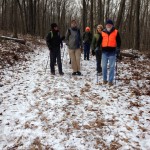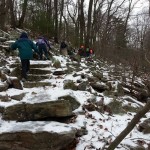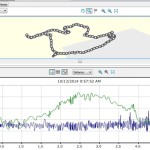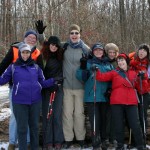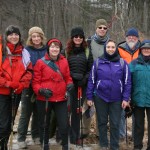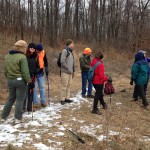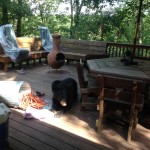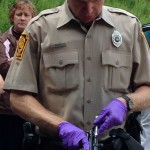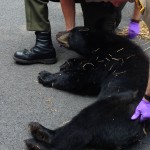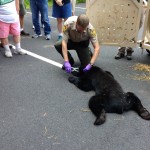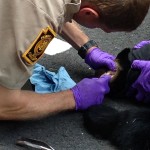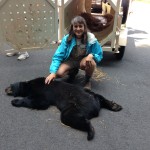- On the trail.
- Group shot on the power lines.
- The ice!
- Our route.
- A silly shot,
- View from the power lines.
- At the end.
- At the top.
It was a cold start to a great day. We had 9 brave hikers who weathered the 19 degree temperatures, including one hiker who lives in California! We began our hike on the East Loop Trail. Once on the steep power line connector trail we followed Janie Trail where we ran into problems. It was too icy for those without Yak Traks or Micro Spikes, so we had to go off trail to reach the top of the mountain. While we broke a “Leave No Trace” policy, the priority was the safety of the hikers. We had planned on hooking up with the Coach Trail, Creek Trail and return on the Pond Trail, but icy conditions required we cut the hike short. We ended staying on Janie Trail, intersecting Lower Springs Trail and following it back to the parking lot.
- Mama bear on my deck.
- Mama looks into my window,
- Baby bear on a bench.
Prior to starting the hike we had a brief presentation on Black Bears in the education pavilion. It started with the “true – false” test below. Try taking it yourself and see how well you do before reading on for the answers.
QUESTIONS:
- Two species of black bears live in the wild in PA – the grizzly bear and the black bear.
- The main food of the black bear is meat.
- The best way to keep away from black bears is to climb a tree.
- Scientist determine the age of a black bear by counting the rings on a bear’s tooth.
- Black bears can be black, brown, and even cinnamon color.
- In PA bear cubs are born in April.
- Black bear cubs usually weigh around 5 lbs. when they are born,
- Black bears are true hibernators.
- Black bears return to the same den year after year.
- Black bears will not den near people.
- Black bears can go almost six months without eating, drinking, or excreting.
- Black bears will climb trees to take a rest during the day.
- Because of their large size black bears are slow.
- Feeding black bears in the wild is unlawful.
- Black bear populations in PA are low because of lack of habitat.
Whew! Did you make it through all those questions? Let’s see how well you did. Now for the answers….
ANSWERS
- False: The black bear is the only bear in PA. There are three different kinds of bear in North America. Can you guess???? They are the black bear, brown bear and polar bear. The grizzly bear is a type of brown bear. Scientist believe the melting ice caps up North have required the polar bear to go inland in search of food where they are coming in contact with brown bears. A few different kinds of bears are turning up, believed to be the outcome of polar bears cross breeding with the brown bear.
- False: Bears are omnivores, meaning they basically eat anything. Seventy percent of their diet is herbivore or plants. Black bears have been known to eat carrion, fawns, and injured or weak deer.
- False: Do not climb a tree if you cross paths with a black bear. They are great tree climbers and they send their cubs up a tree when there is danger. Your response may make mama bear think you are after her cubs. If the bear does not see or hear you talk softly and walk away. Do not make eye contact! If you have been seen or heard back up slowly, remember no eye contact. If the bear charges you, make yourself as big as you can and make as much noise as you can. If the bear grabs you fight back with all you are worth. If grabbed by a grizzly, play dead. Bears have an excellent sense of smell and hearing. There eyes pick up any movement. So bears will probably know of your presence before you are aware of them. Most bear attacks are by males that sneak up without your knowledge. A female will give you many warnings even when cubs are involved. She may swipe the ground, growl, snap her jaws, and make false charges.
- True: When bears are trapped and anesthetized, the small tooth far in the back of the mouth is removed and sent to a laboratory where small shavings of the tooth are viewed under a microscope. Rings appear for each year of growth, much like that of a tree.
- True: Not only can black bears be black, brown or cinnamon, while a rarity, they can be blond!
- False: In PA, bear cubs are born in the den in January, while mom is sleeping. They are born hairless, eyes closed and with a keen sense for heat. Mama’s nipples give off a great deal of body heat so the babies have no problem attaching to a nipple. Black bears have an implantation mechanism. Bears mate in June/July but the embryos don’t start to grow until late fall.
- False: Cubs weigh 10 ounces when born. Mom is around 280 lbs. heavier than a cub. Human babies would weigh one and a half pounds given the same ratio.
- False: Black bears are not true hibernators. Their body temperatures do not decrease enough to be considered hibernation. They go into a state of torpor or a torpid condition. This means if the weather becomes unseasonably warm black bears may come out of their dens. Hummingbirds also go into a torpid state every night or else they would starve to death while sleeping!
- False: Bears den in caves, under logs, dug out banks, under bushes, wherever they find a suitable place for a den. They do not return to the same den each year.
- False: Black bears will den around people. Recently their appearance in urban areas, where they have learned to live off garbage and bird feeders, has earned them the term of “Urban Bears”.
- True: Black bears can go almost six months without eating, drinking, or excreting. They must put on a lot of weight in the fall so they can live off their fat. In the spring they will eat one of the first plants to grow, the skunk cabbage, which flushes out the fecal plug that formed during the denning period.
- True: The black bear will rest in trees during the day. They are the only bears in North America that can climb trees. Black bears are crepuscular, meaning they are most active at dusk and dawn.
- False: You cannot outrun a black bear. They can run 35 miles per hour.
- True: It is unlawful to feed a black bear anywhere in PA. Including bird feeders. If a black bear is eating from your feeders remove the feeders for about a month, then try again. Bears have great memories. Remember a fed bear becomes a nuisance bear. A fed bear ends up a dead bear.
- False: Bear populations are high in PA. There are about 18,000 bear which propagate at a higher rate than in any other state having black bears due to the amount and variety of food sources available to them in PA.
How did you do? Get them all right? Do you want to know how and why they trap and anesthetize bears? If so, read on.
- The side view of a culvert trap,
- There is a bear in there.
- Everyone takes a peek.
- Getting the dart gun loaded.
- Darting the bear.
- Ready for the salve and eye covering.
- Measuring the chest.
- Tagging the ears,
- Removing a tooth.
- A beary nice picture of me!
Trapping bears and anesthetizing them allows one to obtain important information about bears and the bear population. Culvert traps with donuts inside are often used to trap bears. When in the trap the bear is anesthetize with a dart gun or a needle attached to a large pole. Once asleep salve is put on the eyes to protect them from drying out. The eyes are also covered to decrease trauma, since the bear is somewhat aware of its surroundings. The sex of the bear is recorded and the circumference of the chest measured to gain an estimate of the bears weight. The bear is given the once over for injuries, mange or any malady that may effect the bear’s health. Numbered tags and tattoos are placed in both ears for future identification. Sometimes a tracking collar is placed on the bear. The reason for tattoos is because the tags are often torn out during fighting or mating. As mentioned earlier, a small tooth in the back of the jaw is removed. This tooth is of little use to the bear but will determine the bear ‘s age. Often bears who become a nuisance are trapped and relocated. Unfortunately, bears have been known to return up to 100 miles away.
Now you are a black bear expert. Take what you know and share it with others so we can all live in harmony with the PA Black Bear.


